 |
Spitfire
V BL585 - Aspull, Wigan 13th February 1942 |
 |
Spitfire
V BL585 - Aspull, Wigan 13th February 1942 |
Updated on 27.03.2010
| Type | Unit | Base | Duty | Crew | Passengers |
| Spitfire Vb | No. 308 Squadron | Woodvale | Combat exercise | 1 | - |
The fate of this 308 Squadron
Spitfire from the RAF Woodvale airfield near Southport, had for many years posed
something of a mystery to Aviation Archaeology enthusiasts in the North West.
Although the loss of this machine was clearly recorded in the Squadron’s
Operational Record Book (ORB), no location was given and as usual, there was no
Form 1180 available that might give further information. In fact, the mysterious
loss from the records of almost all the Form 1180s relating to incidents
involving Spitfire V aircraft in the North West, has for many years made
research more than a little difficult in our area. However the ORB entry was
quite detailed, noting that the pilot “baled out” during a practice dogfight
and as much of this activity from Woodvale was known to have been carried out
over the sea, many enthusiasts simply concluded that this is where BL585 had
ended up. However never being one to completely write off any lead, without some
from of proof, the details of BL585 joined the list at the back of my file in
the hope that sometime in the future further information may come to light. It
was to be several years later, whilst researching the loss of a B-24 Liberator
42-7467
which crashed at Aspull near Wigan, that the missing piece of the BL585 puzzle
not only came to light, but proved that there was a very good chance that the
remains of this aircraft still lay where it had crashed!
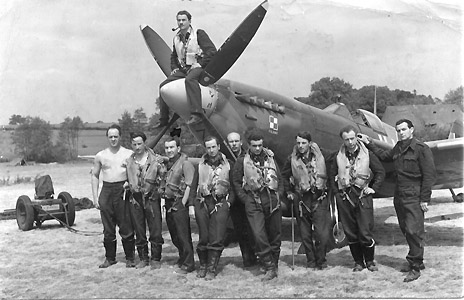 |
| 317 Squadron pilots in a relaxed pose at Chailey in May 1944 - Flying Officer Boleslaw Paley is seated astride the Spitfire’s propeller! |
| Name | Position | Status |
| F/O B. H. Paley | Pilot | OK. |
On
the morning of Friday the 13th February 1942 , BL585 was being flown
by Flying Officer Boleslaw Paley P-0347 (Palej – correct Polish spelling), of No 308 Squadron based at
RAF Woodvale near Southport. F/O Paley was conducting mock dog-fighting
exercises with Sergeant Majchrzyk, when it seems Paley bailed out of his
aircraft! At the subsequent inquiry, he later admitted that there was no failure
in the aircraft, but that he blacked out and only came to when he found himself
no longer at the controls of his aircraft, but falling through the air with his
parachute unopened. It seems that fortunately for Paley, that in his unconscious
state, his training took over and he successfully bailed out, the rush of cold
air then bringing him round. Below a young local aircraft spotter had been
watching the Spitfires and was surprised to see a parachute blossoming in the
sky as one of the aircraft dived towards the ground. Later he made his way to
the crash site and even managed to ascertain the aircraft’s serial number,
which he added to his meticulous records in a small notebook – a hobby that
could have landed him in serious trouble in wartime! Meanwhile Paley had landed
safely in the yard of a colliery at Golborne, where upon his arrival he was
nearly set upon by the miners coming off shift, because his Polish accent he was
at first mistaken for a German!
Though
the wartime notebook confirmed beyond doubt the identity of the aircraft, it did
not actually pinpoint the location of the crash, but we thought that such an
incident would surely be recalled locally? However, the only eyewitnesses we
managed to trace now lived in the USA, though he was able to suppy us with a
rough sketch map via email. We soon realised that the area indicated had changed
considerably since WWII due to mining activity and changing farming methods.
With the landowner’s permission, we arranged to carry out an extensive
grid-search metal detector survey of the area and after a long wait due to
ground conditions, the Foot and Mouth crisis and crops, we finally mustered five
detector users for a systematic search. After several hours of picking up old
pennies, scraps of lead and assorted fragments of iron farm implements, one of
our members finally found a small scrap of crumpled aluminium, soon followed by
another with a couple of countersunk rivet holes visible, when the mud was
scraped away. An intensive search of the surrounding area yielded only a further
handful of shapeless aluminium fragments, an aircraft battery clamp wing-nut and
a couple of .303 calibre tracer bullet heads. Not a promising start, but we duly
pegged out the finds and assembled our two deep-seeking detectors. Firstly the
Fisher proved troublesome to tune due to mineralisation as the fields in the
area were regularly covered in “night-soil” from the nearby towns in
Victorian times, which included ash from the local industries. However with
perseverance it registered a medium sized contact in the expected area. Our
Forster machine had no problem with the ground conditions, but gave some rather
confusing (at the time) readings, with two deeply buried contacts some 15 feet
apart and a large contact in the same central area indicated by the Fisher, but
apparently close to the surface. We concluded this was due to the Forster
machine only picking up ferrous metals and the Fisher detecting all metals,
indicating that the remaining wreckage was well broken up and from the readings,
clearly the Rolls Royce Merlin engine was no longer present.
|
|
 |
|
Three to four feet down and very few finds as yet, but the tell-tale discolouration becomes clear. |
At around eight feet down the first significant pieces of BL585 began to be uncovered |
The Landowner was less than impressed with our meagre finds and obviously not convinced that the remains of a WW2 fighter lay beneath his field, but was still kind enough to give his consent for an excavation of the site, on the condition that the dig was to be conducted without a mechanical excavator. Fortunately in the absence of any official records indicating where BL585 had actually crashed, the MOD accepted our evidence and a permit was issued. With all the formalities dealt with, we finally arranged for the excavation to take place in September 2005 – some five years since the notebook had first come to light. Several members of the team gathered armed with spades and trowels on a fine Saturday morning, but by lunchtime, the heavy, compacted clay soil was taking its toll and we had barely reached some three to four feet in depth, with only a few small finds and a heavy iron bar lying ominously across the centre of the excavation. Once this 12 foot long obstacle was finally removed, the area was re-scanned with the deep-seeking detectors and we were relieved to find the signals still distinctly discernable. A consultation with the farmer’s wife, who by now had become fascinated by the project, having a keen interest in more modern aviation as well as holding a pilot’s licence, elicited permission to bring in a small mini-digger. Sunday brought another fine day, with a 3-ton Volvo mini-digger on site and one of our members being a skilled plant operator, it was soon put to work. The first few feet that we had laboriously dug through the day before were cleared in minutes and we were kept busy checking through the spoil as it was removed for smaller finds. As digging progressed, an area of soft grey clay with small pockets of wreckage and a distinct smell of fuel and oil was soon apparent in the centre of the excavation, contrasting with the surrounding natural red clay soil. The hole was also widened towards the first of the Forster contacts, which proved to be a .303 Browning machine gun embedded vertically, its rear end some two feet below the surface. This was carefully excavated by hand.
|
|
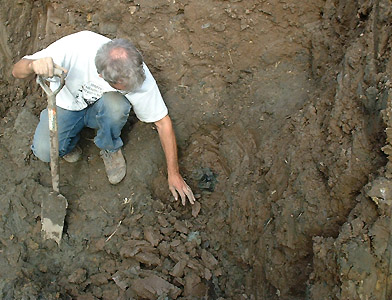 |
| .303 Browning machine gun embedded almost vertically into the ground |
Not much to see - but the back end of a Hispano 20mm cannon is first revealed - Note the undisturbed clay surrounding it. |
Concentrating on the centre area, we began to encounter larger fragments of BL585 at around eight feet down and an almost intact compressed air bottle was recovered together with larger pieces of airframe structure, many showing signs of fire damage. But, as the hole got deeper, we soon found the limitations of using such a small machine and had to “ramp-in” the digger to reach the bottom of the hole and at around 10 feet deep we hit another cache of wreckage and three volunteers descended to remove these parts by hand. These included the throttle quadrant and radio tuner push-button controller from the cockpit and an amazingly well preserved pilot’s access door, with full locking mechanism to the inside and intact paint to the outer surface with the top bar of the letter Z clearly visible - The squadron code letters were “ZF” (Polish nickname “Zefiry”). Finally at approximately 12 feet we recovered two Merlin engine exhaust stubs impacted into the hard clean clay at the bottom of the hole indicating this was as far as the aircraft had reached.
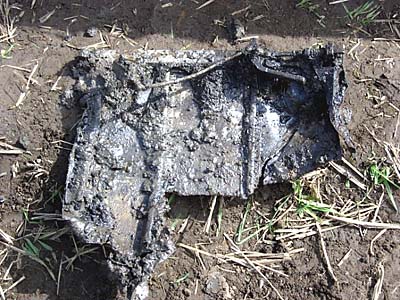 |
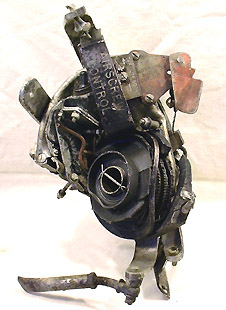 |
| The Cockpit access door |
BL 585's Throttle quadrant |
The Forster was brought in to check nothing else lay deeper and it still indicated two strong signals, now to each side of the 12-foot deep excavation and on climbing out something was spotted protruding from the natural red clay side of the hole. A trowel was called for and after two minutes scraping, the oil buffer from the rear of a 20mm Hispano Cannon was revealed – still firmly attached to something very solid. As the clay was cleared by hand, revealing more of the weapon’s breech, the digger began to clear the natural clay to the same depth at the opposite side of the hole, where the second contact was still indicated. This revealed a second oil buffer, again attached to the breech, with the gun pointing straight down. The problem now, was that the back of one gun was at nine feet down, the other at ten feet and we knew that these weapons were over eight feet long! We cleared around the breech of each gun as far as we could and attached heavy-duty nylon lifting straps. The digger then attempted to pull each gun free vertically, as everyone kept well back, in case the strain proved too much and snapped the straps. Progress was painfully slow and everyone found themselves willing the guns to rise from their 63 year entombment. Slowly and almost imperceptibly at first, the clay released its grip and then without warning the eight and a half foot long cannon hung in the air, the barrel perfectly straight and still looking menacing as its black finish showed through the clay. Though slightly deeper the second gun proved easier to remove, as the clay surrounding it proved much wetter and softer. Once on the surface we found both guns still had their distinctive early muzzle brakes intact and the farmer, who had returned to see how we had got on, was much more impressed.
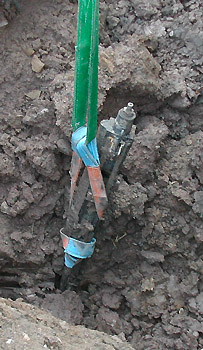 |
|
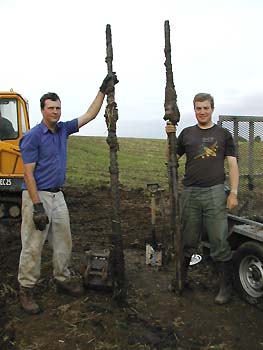 |
| Slowly the clay releases it grip | The first cannon is lifted clear | A satisfactory conclusion to our dig |
The following weekend, suitably rested, members of the team re-assembled to clean and sort the finds, uncovering several smaller plates and artefacts amongst almost half a ton of shattered metal fragments. These included; the Rolls Royce engine makers plate, remains of the cockpit clock, gun camera film indicator, brake gauge and a plate bearing the aircraft’s serial No. BL585. The weapons, which had been reported to the local police in accordance with firearms legislation, were cleaned, checked and found to be clear of ammunition. After inspection the Hispano 20mm cannon were sent to be de-activated and certified, though the .303 Browning was deemed to be outside the terms of the act and no longer a weapon due to damage and corrosion.
 |
|
Clearing the barrels of the Hispano 20mm cannon. |
Boleslaw Henryk Palej joined the Polish Airforce in 1937 and was commissioned with the rank of Pilot Officer on the 1st September 1939. With the beginning of the war all pilots in his year were evacuated to Romania and then by train to France via Italy arriving at Lyon in January 1940 and following an illness, he was posted to Chateauroux airfield, arriving in March 1940. By June his unit was once again on the move and he arrived in Bordeaux on 18th left for the UK the next day on board the Polish ship "SS Kmicic". Upon arrival in England he first went to RAF Blackpool and was then sent to a operational training unit on the 1st March 1941, before being posted to No 245 squadron in May, based at Aldergrove in Northern Ireland, carrying out defensive duties. In July he moved to No. 303 Squadron at Speke tasked with the defence of Merseyside. From there he went to No. 308 Squadron in September, whilst they were at Northolt undertaking bomber escort missions over France before they moved to Woodvale. Following their time at Woodvale, 308 Squadron resumed offensive operations, based at Exeter from the 1st April 1942, Hutton Cranswick near Driffield in Yorkshire, from the 7th May and Heston on the outskirts of London, from 30th July. On the 8th October he was awarded the Polish Cross of Valour and on the 29th of that month the Squadrom moved back to Northolt to provide defensive cover when German night attacks on London resumed, before returning to Yorkshire on 29 Apr 1943 to Church Fenton.
In May 1943 Palej was back at Heston,
this time with No. 317 Squadron, flying offensive sweeps over Northern France,
moving to Perranporth (Cornwall) on the 7th June and then to Fairlop,
Essex on the 3rd August. In September 317 was back at Northolt to re-equip with
the Spitfire Mk IX and in December along with Nos. 308 and 302 Squadrons, 317
became part of the new 131 Polish Wing, as part of the Second Tactical Air Force
in preparation for the forthcoming invasion of Europe. At this point Palej was
posted to an unknown unit at Croydon from December 1943 to May 1944 when he was
reassigned to No 317 Squadron, now based at an RAF
Advanced Landing Ground (ALG) at Chailey
in East Sussex and promoted to
Flying Officer. From here he flew offensive sorties over France and Belgium,
escorting bombers and also attacking ground targets and the invasion approaching
the pace increased and such flights became more frequent, with the entire wing
including 317 Squadron engaged in four full-strength patrols over the Normandy
beaches on D-Day itself from 05:20 until their final return at 21:00.
 |
| Portrait of F/O Paley drawn by a fellow POW whilst in Stalag Luft III “Sagan”. |
The following day, the 7th
June, the Squadron was sent to cover the beach at "Omaha" where the
American forces were in a critical position. Low cloud and poor visibility
forced them to fly very low to locate the German gun positions and Palej was
forced to abandon his aircraft, Spitfire IX MJ310 (JH-J) following an engine
failure, which he believed to have been caused by ground fire. He left his
aircraft over Isigny-sur-Mer,
and after bailing out he landed between the Allied and German lines, with
soldiers of both sides rushing to get to him first, the Germans were faster and
he became a prisoner of war. After interrogation, being paraded in Paris for
propaganda purposes and a particularly harrowing five days & nights train
journey with no water or food, he ended up at Stalag XIIA at Limburg before
being moved to Stalag Luft III at “Sagan” (now
Żagań in Poland ). On
the 28th January 1945 the camp was evacuated and he was marched a
total of 100 km in three and a half days, with two Americans dying en route and
a German guard suffering frostbite on his legs. The POWs were eventually
liberated by the Americans on 29th April and Palej returned to the UK
on 7th May 1945 when he returned to RAF Blackpool and took up staff
duties at the Polish Airforce HQ with the rank of Flight Lieutenant.
During
the war Boleslaw Palej had married and had a daughter in 1943, after the war he
later remarried and had a further two sons & two daughters, as well as his
native language, he could speak Russian, German and English and was an
electrical engineer by trade. He apparently found the return to Civilian life
difficult and regularly attended Polish Air Force Reunions. He died in London on
the 8th May 1996 after a long illness.
Mark Gaskell, Eric Turner, Hugh Heyes, Colin Duncan, Wilhelm Ratuszynski, L. Domanski, Alan Clark, Mark Sheldon.
This page & all articles on this site Copyright © Nick Wotherspoon 2010